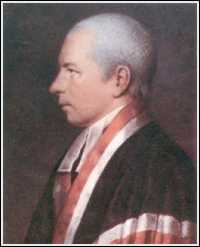FRtR > Biographies >
William Paterson
A Biography of William Paterson 1745-1806
*** Quote ***
 William Paterson (Patterson) was born in County Antrim, Ireland, in 1745. When he was almost
2 years of age, his family emigrated to America, disembarking at New Castle, DE. While the
father traveled about the country, apparently selling tinware, the family lived in New London,
other places in Connecticut, and in Trenton, NJ. In 1750 he settled in Princeton, NJ. There, he
became a merchant and manufacturer of tin goods. His prosperity enabled William to attend local
private schools and the College of New Jersey (later Princeton). He took a B.A. in 1763 and an
M.A. 3 years later.
William Paterson (Patterson) was born in County Antrim, Ireland, in 1745. When he was almost
2 years of age, his family emigrated to America, disembarking at New Castle, DE. While the
father traveled about the country, apparently selling tinware, the family lived in New London,
other places in Connecticut, and in Trenton, NJ. In 1750 he settled in Princeton, NJ. There, he
became a merchant and manufacturer of tin goods. His prosperity enabled William to attend local
private schools and the College of New Jersey (later Princeton). He took a B.A. in 1763 and an
M.A. 3 years later.
Meantime, Paterson had studied law in the city of Princeton under Richard Stockton, who later
was to sign the Declaration of Independence, and near the end of the decade began practicing at
New Bromley, in Hunterdon County. Before long, he moved to South Branch, in Somerset
County, and then in 1779 relocated near New Brunswick at Raritan estate.
When the War for Independence broke out, Paterson joined the vanguard of the New Jersey
patriots. He served in the provincial congress (1775-76), the constitutional convention (1776),
legislative council (1776-77), and council of safety (1777). During the last year, he also held a
militia commission. From 1776 to 1783 he was attorney general of New Jersey, a task that
occupied so much of his time that it prevented him from accepting election to the Continental
Congress in 1780. Meantime, the year before, he had married Cornelia Bell, by whom he had
three children before her death in 1783. Two years later, he took a new bride, Euphemia White,
but it is not known whether or not they had children.
From 1783, when he moved into the city of New Brunswick, until 1787, Paterson devoted his
energies to the law and stayed out of the public limelight. Then he was chosen to represent New
Jersey at the Constitutional Convention, which he attended only until late July. Until then, he
took notes of the proceedings. More importantly, he figured prominently because of his advocacy
and coauthorship of the New Jersey, or Paterson, Plan, which asserted the rights of the small
states against the large. He apparently returned to the convention only to sign the final document.
After supporting its ratification in New Jersey, he began a career in the new government.
In 1789 Paterson was elected to the U.S. Senate (1789-90), where he played a pivotal role in
drafting the Judiciary Act of 1789. His next position was governor of his state (1790-93). During
this time, he began work on the volume later published as Laws of the State of New
Jersey (1800) and began to revise the rules and practices of the chancery and common law
courts.
During the years 1793-1806, Paterson served as an associate justice of the U.S. Supreme Court.
Riding the grueling circuit to which federal judges were subjected in those days and sitting with
the full Court, he presided over a number of major trials.
In September 1806, his health failing, the 60-year-old Paterson embarked on a journey to Ballston
Spa, NY, for a cure but died en route at Albany in the home of his daughter, who had married
Stephen Van Rensselaer. Paterson was at first laid to rest in the nearby Van Rensselaer manor
house family vault, but later his body was apparently moved to the Albany Rural Cemetery,
Menands, NY.
 William Paterson (Patterson) was born in County Antrim, Ireland, in 1745. When he was almost
2 years of age, his family emigrated to America, disembarking at New Castle, DE. While the
father traveled about the country, apparently selling tinware, the family lived in New London,
other places in Connecticut, and in Trenton, NJ. In 1750 he settled in Princeton, NJ. There, he
became a merchant and manufacturer of tin goods. His prosperity enabled William to attend local
private schools and the College of New Jersey (later Princeton). He took a B.A. in 1763 and an
M.A. 3 years later.
William Paterson (Patterson) was born in County Antrim, Ireland, in 1745. When he was almost
2 years of age, his family emigrated to America, disembarking at New Castle, DE. While the
father traveled about the country, apparently selling tinware, the family lived in New London,
other places in Connecticut, and in Trenton, NJ. In 1750 he settled in Princeton, NJ. There, he
became a merchant and manufacturer of tin goods. His prosperity enabled William to attend local
private schools and the College of New Jersey (later Princeton). He took a B.A. in 1763 and an
M.A. 3 years later.